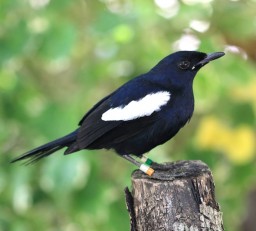Protecting Seychellois birds from disease
12/11/2014
Wildlife medicine support for the Seychelles
Disease is causing a significant number of deaths for the Seychelles Magpie Robin, one of the Seychelles most iconic and endemic species. This new threat has prompted the latest development in WVI’s veterinary programme.

Wildlife medicine support for the Seychelles
Disease is causing a significant number of deaths for the Seychelles Magpie Robin, one of the Seychelles most iconic and endemic species. This new threat has prompted the latest development in WVI’s veterinary programme.

Infectious disease poses a major threat of extinction to small, endangered wildlife populations, as many of the Seychelles’ species have been reduced to. Without help, the Seychelles’ unique biodiversity of flora and fauna, one of the big attractions for tourists, could diminish suddenly despite the hard and successful work of Seychellois conservation organisations.
Some flagship species have already suffered catastrophic population declines with some lost forever.
WVI founder, director and avian specialist Dr Andrew Greenwood is in the Seychelles to discuss a conservation medicine training programme.
The aim is to avert further extinctions by equipping vets and conservationists with essential skills, increase disease surveillance, set up a property equipped pathology lab and enable them to comply with international conservation treaties.
WVI worked in the Seychelles in 2009 as part of a multidisciplinary team helping to rescue the colourful Seychelles paradise flycatchers with the creation of a new island population in 2009.

Under new threat is the Seychelles magpie robin (see the right eye in the adjacent picture). Andrew will be ensuring that protocols to collect samples and identify disease that we supplied earlier in the year are relevant and being carried out correctly.
Overall, WVI’s mission is to train the Republic’s vets and conservationists to deliver conservation medicine themselves, reducing the reliance on international organisations, ensuring the success of their globally-important conservation programmes and saving endangered wildlife throughout the Seychelles.
Amongst those at risk are the Seychelles white-eye, tiger chameleon, Brauer’s burrowing skink, Vesey-Fitzgerald’s burrowing skink and the Seychelles sheath-tailed bat – some of the world’s most endangered animals.
The cost of the programme is calculated at £70,000 and fund-raising has now started.
What is so unique about the Seychelles?
The oldest oceanic islands on Earth, the Seychelles became detached from the African continent before modern mammals evolved. No land mammals occurred on the Seychelles naturally, allowing the evolution of a unique array of flora and fauna, in particular, a wide diversity of bird life and reptiles.
The Seychelles islands – a Global Conservation Hotspot along with Madagascar and Indian Ocean Islands – have seen the extinction of giant Seychelles tortoise and native bird species such as the Seychelles parakeet and chestnut-flanked white-eye.

Illustrating their plight and WVI’s previous contribution, in 1996 the world’s only surviving population of the paradise flycatcher (pictured) stood at around 70 pairs on the island of La Digue, struggling to survive on its 160 hectare area against the common threats of habitat destruction and predation.
Environment restoration on neighbouring Denis Island and a strict WVI disease surveillance programme helped move healthy birds to establish a viable new population. Today’s figures show a total population of 270 individuals – and growing.
Seychelles conservation agencies are backing the scheme, including WVI partner Nature Seychelles with support from the Seychelles Agricultural Agency, the Island Conservation Society and the Marine Conservation Society, Seychelles. Donate to help

WVI in the Russian Far East
WVI has been working in the Russian Far East providing veterinary advice on the conservation of Amur leopards and tigers since 2006.
WVI is one part of the conservation ‘toolbox’ and works as part of a multidisciplinary team under the banner of Amur Leopard and Tiger Alliance (ALTA). WCS Russia is another member and one which WVI has worked closely with over the years.
WVI’s big cat and anaesthesia specialist has spent a number of trapping seasons as part of multiorganisation team, trapping tigers and leopards to fit radio collars and to gather as much information about a wild tiger or leopard as is possible.

John therefore has been training and supporting Russian wildlife vet Michael (Misha) Goncharuk and has trained many Russian field biologists in safe immobilisation of big cats in the field, correct sample taking and storage and the role disease plays in the conservation of these endangered big cats.
The latest
Over the past few years it has not been possible to obtain trapping permits and John’s trips to Russia have become more infrequent.
However, John continues to provide support from the UK and it has given time for John to look at the data that has been collected over the years.
As part of the Reintroduction Plan, WVI is writing an analysis of the diseases that pose a risk to the current population of Amur leopards and how they might be mitigated. In addition, there is a risk to and from the proposed second, reintroduced, Amur leopard population that will come from captive stock in Eurasia.
Data collected by John and the Russian biologists and vets from the tigers, leopards and other carnivores in the area have been analysed by epidemiologist Dr Alex Thomlinson.
The framework that gives the background to the DRA and explains where the risks are has been completed and has been published in English and Russian.
.png)
.png)

.png)
.png)







.png)






.png)
.png)




.png)


